Introduction
The chord progression you use over a particular melody line can significantly alter the feel and sound of a song. It can also influence the genre that song falls into. Each style of music has particular chord progressions that are typical of that style. Further, the melodies of each genre interact with the harmony in particular ways. To demonstrate this we will look at the first 8 bars of the Beatles song All My Loving and then perform a reharmonization on it – thus fitting it into a number of different music genres.
Specifically, we will look at the types of chords used, the types of chord progressions used, and how the melody interacts with the harmony for each reharmonization style.
Pop Harmony
Pop music tends to use triads, use diatonic chord progressions (that is, chords all from a single key) and the melody tends to target the root of each chord. For the purposes of this exercise, let’s assume the note we are ‘targeting’ is the first note of each bar (when the chord changes). This isn’t necessarily always the case, but it’s a good approximation.
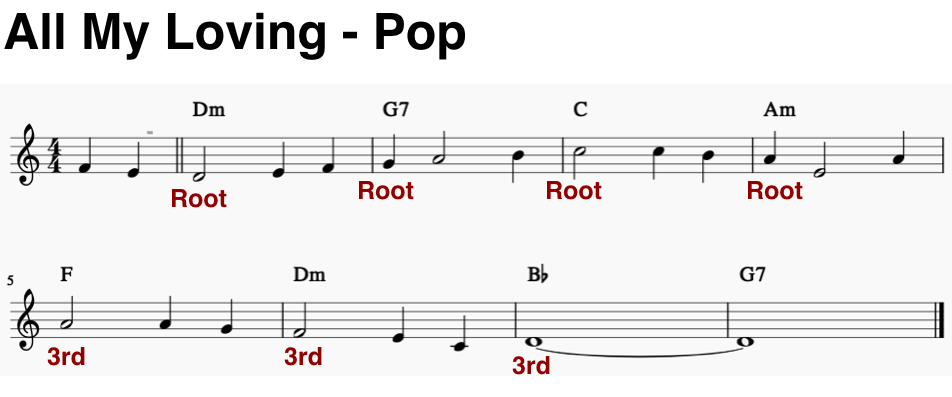
In All My Loving, we do indeed see that most of the chords are triads (except for the G7’s), the chord progression is mostly using chords from the key of C Major (except for that Bb at the end), and the melody is largely just targeting root notes (and then some 3rds at the end). So this song is both very typically of a Pop song, but also bends the rules a little bit. And this is what made the Beatles such great song writers. They could have written a boring chord progression that just stayed in the key of C the whole time, but instead they added a tiny bit of spice by putting in that one foreign chord (B♭). Very subtle, but very effective.
Tonal Jazz Reharmonization
Tonal Jazz uses 7th chords, uses lots of 2-5-1’s (usually by modulating down through a number of key either by half step, whole step, or fifth), and targets guide tones (3rd & 7th) or available tensions (9th, 11th, 13th). So if we reharmonize this melody such that we adhere to the above ‘rules’ then we should get a nice Jazzy version of All My Loving.
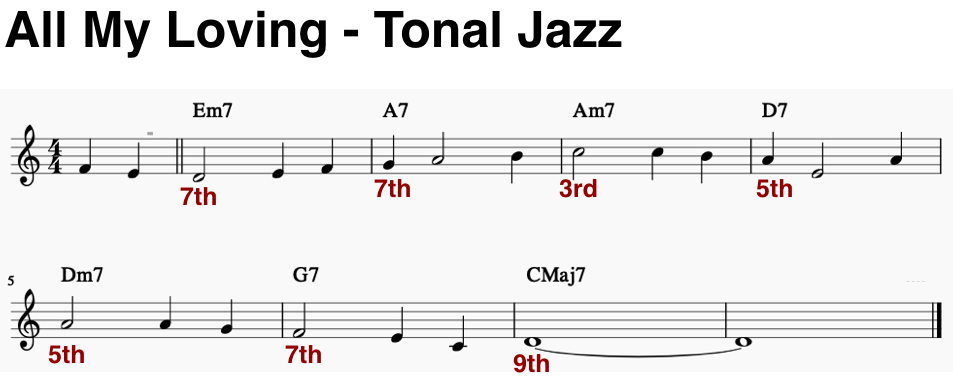
Notice that we are now using 7th chords, cascading 2-5’s descending by a 5th (through the keys of D, G and C), are mostly targeting guide tones and finish on that lovely 9th at the end (an available tension). Notice also that even though this melody is clearly in the key of C Major (it only uses the white notes), we have forced modulations over this melody by shunting in chords from different keys.
Modal Jazz Reharmonization
Modal Jazz uses 7th chords, the chords tend to move by step, and the melody again targets guide tones and available tensions (this isn’t 100% true, but we are ignoring character tones for the purposes of this lesson – though, of course, you could change the melody to target the character tone of the relevant mode). So again, doing this should get us a Modal Jazz version of the song.
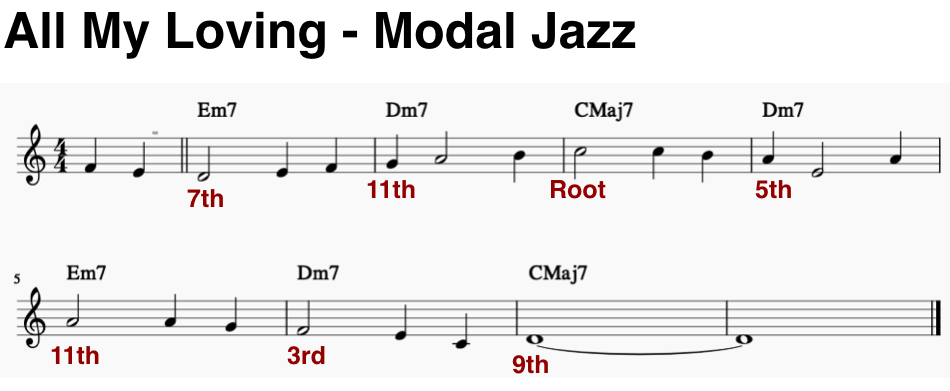
Again, notice the 7th chords, stepwise harmonic movement, and guide tone/available tension targeting.
Atonal Jazz Reharmonization
Now here, we could just mash the piano randomly to create atonal ‘tone clusters’. This could create a very dissonant atonal version of All My Loving. But instead of doing this, let’s make a (relatively) consonant atonal version of the song. To do this we use 7th chords, pick quasi-random chords such that they do not relate to each other in any way (i.e. no two consecutive chords are from the same key), and let’s have the melody target guide tones and available tensions again.
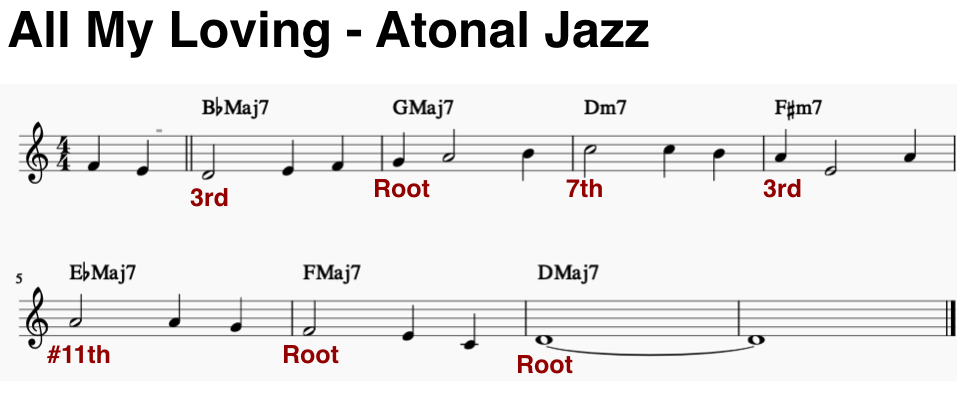
Here, notice the 7th chords, the unrelated and seemingly random chords, and guide tone/available tension targeting.
Blues Reharmonization
To make song Bluesy we would use only dominant 7 chords, use a I-V-IV-I type progression, and have the melody target the ‘blue notes’ of the key (♭3,♭5,♭7). We could also use a Blues ostinato bassline pattern. Let’s try reharmonize this melody into an 8 bar blues in G.
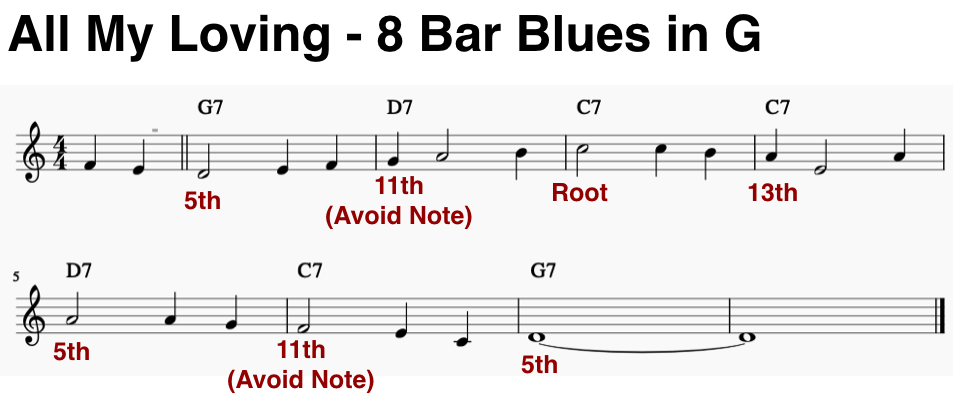
Now, as you can see, superficially, this looks to be a bit bluesy – based on the chords and progression structure. However, it doesn’t really sound very bluesy, and that’s because the melody is not targeting those blue notes. This melody is just not a bluesy melody. We plopped in some bluesy chords, but that hasn’t made it a Blues song because the melody just doesn’t target the right notes. We could, of course, change the melody to target some blue notes, but you can try this yourself (or watch the video). Notice also the targeting of natural 11’s. While in Western Harmony natural 11’s are avoid notes over V7 chord, in the Blues they are perfectly fine and even encouraged.
Techniques
As well as reharmonizing the song, we could also apply different techniques to it to change the sound and feel. Above I suggested using a Blues ostinato bass pattern. We could also use techniques like walking basslines, and Bossa Nova ostinato bass patterns, and locked hands. This last technique is actually both a technique and a reharmonization (an example of a Locked Hands-like technique is shown below – I have slightly modified it, however, just coz I could).
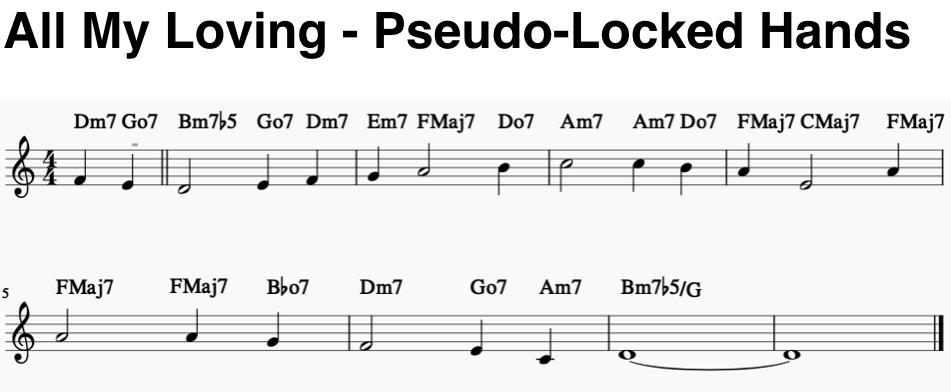
And that’s it for this lesson. Hopefully you found this somewhat interesting and useful and can see that the chords you choose over a melody can have a significant impact on how the song sounds and even what genre it’s in.